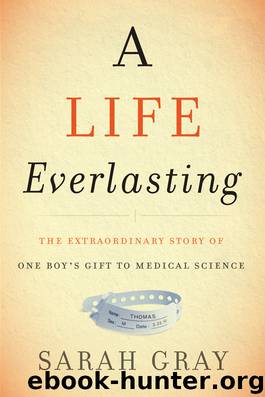A Life Everlasting by Sarah Gray

Author:Sarah Gray
Language: eng
Format: epub
Publisher: HarperCollins
Published: 2016-08-26T04:00:00+00:00
Thomas Gray was a Cytonet donor. Died 3/29/10.
It had been so difficult for me to give away Thomas’s organs and not know what happened to them. I imagined that it must be hard for researchers to receive an organ from a fellow human being and not feel some kind of curiosity, or sympathy, or connection. I took that message on the break room wall as a sign: they have been wondering about us, too.
During our lunch, we had learned that it was Sonya who received the package with Thomas’s liver and, in fact, held my son’s liver in her hands. Part of Sonya’s job was validation, which means coming up with new ways to clean and freeze the liver cells, then testing these methods over and over and over to make sure they are really working.
Before we left, Mark looked up the liver-processing records from the week Thomas died. Though the name was not revealed, Mark found the records of a baby boy who had died on March 29, 2010, and whose liver was recovered and donated through WRTC. Since this was the only neonatal liver to arrive at Cytonet around that time, it was clear to me that the liver in this record was Thomas’s.
When Thomas’s liver arrived at Cytonet, it showed some signs of bruising, which was a result of pooled blood that could not be flushed out after surgery. Sometimes this is the result of an abnormality in the anatomy of the liver. As a result, his liver was not in the best condition for the cell isolation procedure for patient treatment purposes, so the cells were not injected into a baby with a urea cycle disorder. Instead, Thomas’s liver was used in a study that Cytonet was performing on the ideal temperature for freezing neonatal liver cells. This study required the donation of six neonatal livers; that might not sound like much, but it took approximately five months for Cytonet to get all six. The child who had died on March 29, 2010, had donated liver number three.
I pictured Thomas as a member of a six-baby NBA dream team.
When the study was complete, it showed that neonatal liver cells can be frozen at the same temperature as adult and pediatric liver cells, which is minus 150 degrees Celsius. For the scientists, this information was vital for the work they were doing. From then on, minus 150 degrees Celsius would be a secretly special number to me.
“You remember that there are names, there are sisters and mothers and fathers of these donors,” Sonya said that day. “It’s not just a liver. Without the family making that sacrifice even though they know it’s not going to another person directly—we have to remember that their sacrifice is helping someone else.”
Though it was clear that the liver that arrived that day was Thomas’s, we could never be 100 percent sure because of the agreement of confidentiality. We heard another story that brought home the challenges the staff faced in working with anonymous, or “de-identified,” samples.
Download
This site does not store any files on its server. We only index and link to content provided by other sites. Please contact the content providers to delete copyright contents if any and email us, we'll remove relevant links or contents immediately.
| Administration & Medicine Economics | Allied Health Professions |
| Basic Sciences | Dentistry |
| History | Medical Informatics |
| Medicine | Nursing |
| Pharmacology | Psychology |
| Research | Veterinary Medicine |
The Salt Fix by Dr. James DiNicolantonio(1639)
Rebecca Skloot by The Immortal Life of Henrietta Lacks(1631)
Stiff - The Curious Lives of Human Cadavers by Mary Roach(1425)
Rigor Mortis by Richard Harris(1381)
Undue Risk by Moreno Jonathan D.;(1297)
The Telomerase Revolution by Michael Fossel(1284)
Extremes: Life, Death and the Limits of the Human Body by Fong Kevin(1196)
07 by H. M. Ward(1138)
01 by H. M. Ward(1110)
02 by H. M. Ward(1102)
Kathryn Bowers & Barbara Natterson-Horowitz by Zoobiquity(1102)
Essentials of Biostatistics in Public Health by Sullivan & Sullivan(1093)
06 by H. M. Ward(1083)
03 by H. M. Ward(1038)
05 by H. M. Ward(1031)
Why We Snap: Understanding the Rage Circuit in Your Brain by Douglas Fields(1025)
04 by H. M. Ward(1016)
Critical Thinking: Understanding and Evaluating Dental Research by Donald Maxwell Brunette(1002)
A Life Everlasting by Sarah Gray(986)
